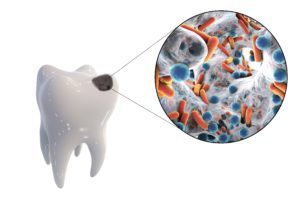 Teeth can last for a lifetime, but cavities are a leading cause of tooth loss. Although they are 100% preventable, 92% of adults have had at least one cavity. Even with the best brushing and flossing habits, tooth decay can occur, but it doesn’t have to lead to missing teeth. Early detection is vital for treating cavities while they are small. Advanced technology allows your dentist to spot the earliest signs of decay using a cavity detection system.
Teeth can last for a lifetime, but cavities are a leading cause of tooth loss. Although they are 100% preventable, 92% of adults have had at least one cavity. Even with the best brushing and flossing habits, tooth decay can occur, but it doesn’t have to lead to missing teeth. Early detection is vital for treating cavities while they are small. Advanced technology allows your dentist to spot the earliest signs of decay using a cavity detection system.
Benefit from the Power of Early Detection
Your enamel is the hardest substance in your body, which protects the underlying dentin and pulp. Although it’s stronger than some metals, it’s no match against cavity-causing bacteria. Sugars from your diet combine with plaque and erode enamel slowly if not removed from your teeth promptly.
Unfortunately, your enamel can’t regenerate and no amount of brushing can reverse decay. With no treatment, it can progress to the inner layers of a tooth, which can cause a serious infection. Instead of needing a filling, you may require a root canal to save your tooth from extraction.
Advanced Cavity Detection System
Your dentist can detect the smallest cavities in the most hard-to-see areas using a cavity detection system. Light illumination shows decay that may not be visible to the naked eye. It provides more accurate results than relying on digital X-rays or your dentist’s eyesight.
Near-infrared (NIR) transillumination makes the enamel appear transparent while porous lesions trap and absorb the light. As a result, the images expose the tooth structure and dental caries. It can even detect the smallest of cracks before they turn into a big problem.
The scanning system doesn’t use any radiation, making it the perfect solution for young children and pregnant women. A quick, pain-free process allows you to benefit from early detection to avoid costly procedures later.
Treating Tooth Decay
The sooner decay is detected, the more options you have to rehabilitate your tooth. Depending on the severity of the cavity and your situation, your dentist may recommend:
- Fluoride Varnish: Applying fluoride to the earliest stages of decay can allow the tooth to remineralize while also making it more resistant to cavities.
- Tooth-Colored Fillings: A composite resin is shaded to match your enamel to treat decay using a metal-free solution.
- Crown: Significant decay can require a dental crown to treat, which will cover the entire surface of a tooth above the gum line.
- Root Canal: Root canal therapy is needed if decay reaches the innermost layer of the tooth.
You only get one set of permanent teeth, so don’t trust your smile to outdated methods. Invest in the best with a dentist who uses a cavity detection system.
About Dr. Kathy Lam
Dr. Lam earned her dental degree from the Howard University College of Dentistry and has regularly continued her education to provide up-to-date services. She embraces the latest technologies to deliver superior dental care. Request an appointment through our website or call (630) 474-6440.
